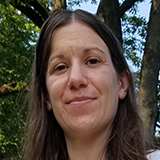Notice of Online Archive
This page is no longer being updated and remains online for informational and historical purposes only. The information is accurate as of the last page update.
For questions about page contents, contact the Communications Division.

assistant professor of neuroscience
Ph.D., neuroscience, University of California San Diego
What I study:
“I’m a biomedical researcher with expertise in neuroscience, genetics, and molecular biology. My thesis work focused on using genetic screening and mapping in C. elegans, which are worms. I mutanized them and looked for phenotypes. I found that to be a really powerful tool, and I wanted to use it in a more complex system. So when I did my post-doc work at the University of Washington, I switched to zebrafish and studying sensory hair cells, which are the cells we use to hear, which is what I work on now.”
What compelled me:
“I’ve always enjoyed science and learning about science. Originally, I thought I was going to pursue genetics. As part of that, I took this behavioral and neural science class in undergrad. I really enjoyed learning how the brain works. Everything we are comes down to these cells and ions and chemicals between one another, and I just found that really fascinating and interesting. So that’s when I changed paths and decided to study neuroscience. In graduate school, I gained experience teaching, and I really enjoyed working with students, and that’s when I realized the education side appealed to me.”
What I’m excited about:
“I plan to continue my research on zebrafish at Lafayette. I study hair cells, which aren’t really in invertebrates, but they are in these fish. You can still use a lot of the tools and techniques on these fish that aren’t really feasible on more advanced, complicated systems. They are also a good teaching tool because they develop in a clear egg, so you can watch these animals go from a single cell to a whole organism. The studies we do are in five-day-old fish, and at five days, they are already swimming around. They have the hair cells that we are studying. Because of the quick development, undergraduates get some meaningful experiences. I like that there is a balance between teaching and research at Lafayette. There are opportunities to improve your teaching, and there are a lot of resources for research. I thought that Lafayette would give me great opportunity to teach while also doing really good research.”

What I’m wearing:
“When I was in graduate school, I had to swap sessions with another instructor to go to my cousin’s wedding, and while I was away, my students took this lab coat, and they all signed it to me and gave it to me on the last day of class. I just thought that was really sweet and was such a very positive first teaching experience. I really enjoy interacting with students and getting to know them, and that’s what appealed to me about becoming an educator.”
Categorized in: New Faculty

